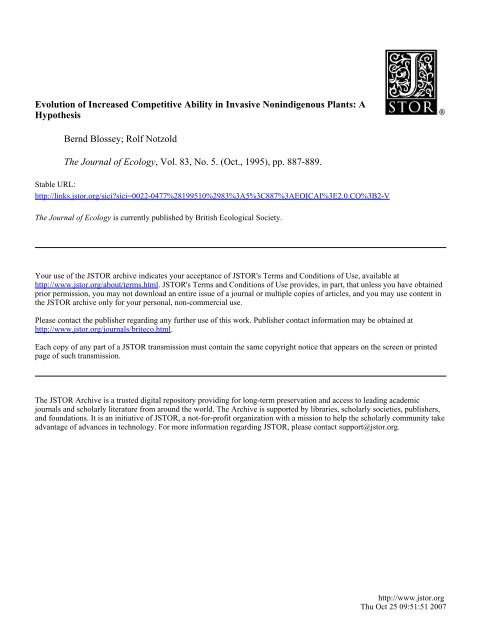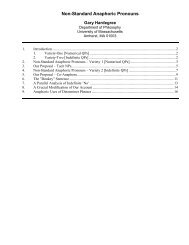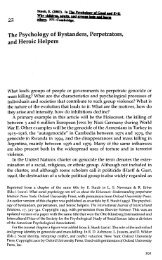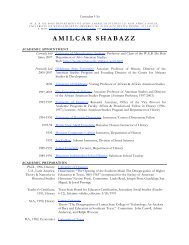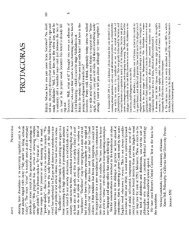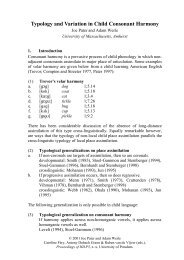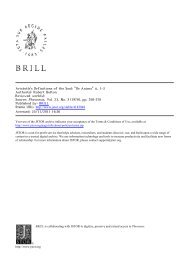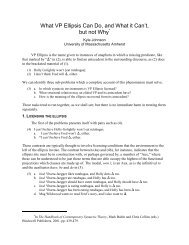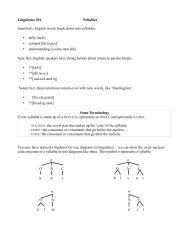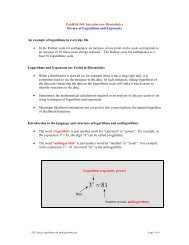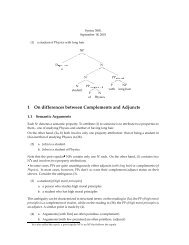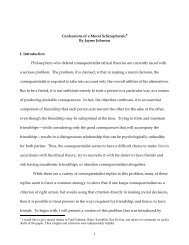Blossey & Notzold, 1995
Blossey & Notzold, 1995
Blossey & Notzold, 1995
Create successful ePaper yourself
Turn your PDF publications into a flip-book with our unique Google optimized e-Paper software.
Evolution of Increased Competitive Ability in Invasive Nonindigenous Plants: A<br />
Hypothesis<br />
Bernd <strong>Blossey</strong>; Rolf <strong>Notzold</strong><br />
The Journal of Ecology, Vol. 83, No. 5. (Oct., <strong>1995</strong>), pp. 887-889.<br />
Stable URL:<br />
http://links.jstor.org/sici?sici=0022-0477%28<strong>1995</strong>10%2983%3A5%3C887%3AEOICAI%3E2.0.CO%3B2-V<br />
The Journal of Ecology is currently published by British Ecological Society.<br />
Your use of the JSTOR archive indicates your acceptance of JSTOR's Terms and Conditions of Use, available at<br />
http://www.jstor.org/about/terms.html. JSTOR's Terms and Conditions of Use provides, in part, that unless you have obtained<br />
prior permission, you may not download an entire issue of a journal or multiple copies of articles, and you may use content in<br />
the JSTOR archive only for your personal, non-commercial use.<br />
Please contact the publisher regarding any further use of this work. Publisher contact information may be obtained at<br />
http://www.jstor.org/journals/briteco.html.<br />
Each copy of any part of a JSTOR transmission must contain the same copyright notice that appears on the screen or printed<br />
page of such transmission.<br />
The JSTOR Archive is a trusted digital repository providing for long-term preservation and access to leading academic<br />
journals and scholarly literature from around the world. The Archive is supported by libraries, scholarly societies, publishers,<br />
and foundations. It is an initiative of JSTOR, a not-for-profit organization with a mission to help the scholarly community take<br />
advantage of advances in technology. For more information regarding JSTOR, please contact support@jstor.org.<br />
http://www.jstor.org<br />
Thu Oct 25 09:51:51 2007
Journal of<br />
Ecology <strong>1995</strong>,<br />
83,887-889<br />
FORUM<br />
Evolution of increased competitive ability in invasive<br />
nonindigenous plants: a hypothesis<br />
BERND BLOSSEY* and ROLF NOTZOLD<br />
International Institute of Biological Control, European Station, 1, Chemin des Grillons, CH-2800 Delimont,<br />
Switzerland; Zoologisches Institut, Christian-Albrechts-Universitat, Olshausenstr. 40, 0-24098 Kiel, Germany<br />
Introduction<br />
There are very few valid generalizations about invasive<br />
species, so that it is only possible to make weak,<br />
probabilistic predictions about which species will<br />
invade (Gilpin 1990; Daehler & Strong 1993). A<br />
phenomenon that has not received much attention,<br />
however, is the observation that, in alien environments,<br />
plants tend to be more vigorous and taller,<br />
producing more seeds than in their native distribution<br />
(Crawley 1987). The seed production of Chrysanthemoides<br />
monilijera (native to South Africa) in<br />
Australia and of Acacia longijolia (native to Australia)<br />
in South Africa is an order of magnitude higher where<br />
the plants are aliens (Noble 1989). The vigour and<br />
success of aliens in areas where they have been introduced<br />
has been attributed to both, more favourable<br />
environments, and to the release from natural phytophagous<br />
enemies (Crawley 1987).<br />
These alternatives can be evaluated according<br />
to two theories relating to resource allocation. The<br />
optimal defence hypothesis predicts that plants with<br />
limited resources will show trade-offs in biomass<br />
allocation among maintenance, growth, storage,<br />
reproduction, and defence (Coley et al. 1985; Bazzaz<br />
et al. 1987; Fagerstrom 1989; Herms & Mattson 1994;<br />
Lerdau et al. <strong>1995</strong>). The environmental constraint<br />
hypothesis (Bryant et al. 1988), however, predicts that<br />
the evolution of defence mechanisms against herbivory<br />
will result in only minor reductions in growth.<br />
Resource availability is then the primary force determining<br />
whether there is surplus photosynthate available<br />
for allocation to secondary metabolism.<br />
Optimal defence theory and invasions: development<br />
of the evolution of increased competitive<br />
ability (EICA) hypothesis<br />
The theoretical framework of the optimal defence<br />
hypothesis can be applied to invasive plants. Invas-<br />
*Present address: New York Cooperative Fish and Wildlife<br />
Research Unit, Department of Natural Resources, Cornell<br />
University, Fernow Hall, Ithaca, NY 14853, USA. Fax:<br />
607 2551895. E-mail: bb22@cornell.edu<br />
iveness of nonindigenous plants is then seen as a result<br />
of shifts in biomass allocation patterns. In the absence<br />
of herbivores, selection will favour genotypes with<br />
improved competitive abilities and reduced resource<br />
allocation to herbivore defence. Competitive abilities<br />
can be maximized by increasing vegetative growth<br />
or reproductive efforts depending on which is more<br />
important for success in a particular new environment.<br />
This hypothesis predicts (a) that, under identical<br />
growing conditions, individuals of a species taken<br />
from an area where they have been introduced will<br />
produce more biomass than individuals taken from<br />
the species native range; and (b) specialized herbivores<br />
(i.e. those with potential for introduction as biological<br />
control agents) will show improved performance on<br />
plant individuals originating from an area where<br />
plants have been introduced.<br />
In preliminary experiments we tested the predictions<br />
of the EICA hypothesis using a comparison<br />
of the growth of Lythrum salicaria L. (purple loosestrife)<br />
plants from two locations (one with and one<br />
without natural herbivory). In addition, we evaluated<br />
the performance of herbivorous insects which had<br />
been studied for their potential as biological control<br />
agents against L. salicaria, on plants from both<br />
locations. Purple loosestrife is an Eurasian wetland<br />
perennial introduced into North America in the early<br />
1800s. Its spread across the temperate part of the<br />
continent has degraded many prime wetlands. Large,<br />
monotypic stands eliminate native plant communities<br />
and threaten endangered plant and animal species<br />
(Thompson et al. 1987; Malecki et al. 1993). Once<br />
established, L. salicaria populations persist over decades<br />
in North America and tend to encroach upon<br />
adjacent areas (Thompson et al. 1987). In contrast,<br />
populations in Europe are rapidly invaded by other<br />
plant species and L. salicaria is a regular but<br />
infrequent component of mixed wetland communities<br />
(Shamsi &Whitehead 1974; <strong>Blossey</strong> 1991). In Europe,<br />
displacement from communities is promoted by specialized<br />
insects which devastate tissues, both above<br />
and below ground, but these insects were absent from<br />
North America until 1992 when three species were
888<br />
B. <strong>Blossey</strong> &<br />
R. <strong>Notzold</strong><br />
Table 1 Mean ( k SE) dry biomass and height at the end of development time or pupal weights in experiments<br />
the growing (N = 20 per group) purple with the leaf-feeder (Table 2). However, excised leaves<br />
loosestrife plants from Ithaca (US) and Lucelle (Switzerland),<br />
Plants were grown in a common garden under were maintained in Petri dishes for raising larvae of<br />
identical conditions<br />
the leaf-feeder and this might have altered their quality<br />
as food for the herbivores. In addition, the results<br />
Ithaca Lucelle P* of our experiments might reflect different defence<br />
investments of purple loosestrife. Foliage is easily<br />
Dry biomass (g)<br />
1991 29.3 & 1.9 16.3 & 1.4 i0.001 replaceable, generally within a few days, whereas root<br />
1992 96.0 k 12.3 28.7 & 4.3 < 0.001 tissue is essential for over-wintering survival, com-<br />
Plant height (cm)<br />
petitive success in the following growing season and<br />
1991 99.7 k 4.4 82.6 k 2.0 0.001 long-term survival. If foliage were less well defended<br />
1992 177.8 k 4.8 109.7 7.4 i0.001<br />
only minor differences would be expected between<br />
*Probability value (t-test).<br />
European and North American plants. This would<br />
explain why larval performance of the leaf-feeder is<br />
not significantly different on plants from Ithaca or<br />
introduced as biological control agents (Hight 1990; Lucelle.<br />
<strong>Blossey</strong> 1993, <strong>1995</strong>; Malecki et al. 1993).<br />
In fall 1990 seeds were collected from at least 20<br />
individual well-spaced plants from populations in<br />
Ithaca, New York, USA and Lucelle, Switzerland.<br />
Alternative explanations?<br />
Seeds were shipped to Christian-Albrechts University, Though we can not exclude the possibility, we believe<br />
Kiel, northern Germany. In spring 1991 seeds were that maternal effects offer no explanation for the large<br />
germinated on a mixture of sand and potting soil. differences observed among plants from Ithaca and<br />
After establishment seedlings were transferred indi- Lucelle. In general, environmentally induced varividually<br />
into clay pots (10 cm in diameter) and kept ation has been demonstrated for species with larger<br />
outdoors in a common garden 30 km south of Kiel. seeds where seeds with higher weight had higher<br />
Plants were grown in commercial potting soil (real viability, germinated faster, and produced more vigsoil,<br />
mixture of Sphagnum moss and compost, nutri- orous seedlings (Nelson et al. 1970). L. salicaria has<br />
ents added by manufacturer) and placed at random. extremely small seeds (0.5mg) and such carry-over<br />
In 1991 and 1992 final plant height and dry biomass effects seem highly unlikely especially if plants are<br />
of 20 plants from each site were determined. We also grown for more than one growing season as in our<br />
tested larval performance of a root-feeding weevil on experiments (Nelson et al. 1970).<br />
potted plants and of a leaf-feeding chrysomelid beetle We also believe that phenotypic plasticity cannot<br />
on foliage of plants from both locations.<br />
be the explanation for the observed differences in<br />
The results of our preliminary tests confirmed pre- growth between introduced and native populations of<br />
dictions that plants from the area with low herbivore a plant species or between European and American<br />
pressure show increased vegetative growth. Plants purple loosestrife. In the absence of herbivory phenofrom<br />
Ithaca grew taller and produced more biomass typic plasticity should lead to increased vegetative<br />
in both years (Table 1). At the same time survival growth not only where species are aliens but also in<br />
of the root feeder was higher and larval weight was their native lands where low and high levels of herincreased<br />
if larvae were raised on plants from Ithaca bivory fluctuate over time but are generally unprecompared<br />
to larvae on plants from Lucelle (Table 2). dictable. Phenotypic plasticity in plant growth should<br />
There were no significant differences in survival rates, reflect the currently experienced herbivore pressure.<br />
Table 2 Performance of a leaf-feeder (Galerucella pusilla) and a root-feeder (Hylobius transversovittatus) on plants from Ithaca<br />
(US) and Lucelle (Switzerland). Survival and development time data of G. pusilla are means (+ SE) of five replicates with 20<br />
larvae each; weight data are means ( k SE) of 19 pupae in each group. Weight data for H. transversovittatus are means (+ SE)<br />
of 32 larvae on plants from Ithaca and 15 larvae on plants from Lucelle<br />
Ithaca Lucelle P*<br />
Galerucella pusilla<br />
Survival (%)L,-Imago 34 k 9.8 40 & 11.4 0.700<br />
Development time (days) L,-Imago 25.9 k 0.5 25.7 & 0.4 0.760<br />
Pupal weight (mg) 4.4 & 0.3 3.9 k 0.1 0.186<br />
Hylobius transversovittatus<br />
Survival (%) 62.7 18.1 iO.Ol**<br />
Larval weight after one year (mg) 42.2 + 5.1 32.6 k 5.8 0.040<br />
*Probability value (t-test). <br />
**Chi-square test x2 = 25.785.
889 The observation that plants grow taller where they<br />
Competitive ability are aliens supports the EICA hypothesis.<br />
in invasive<br />
nonindigenous<br />
plants<br />
Conclusions<br />
The results of our preliminary tests with one population<br />
from each continent supported the two predictions<br />
of the 'evolution of increased competitive<br />
ability' hypothesis. However, the origin of introduced<br />
plant species is not generally well known and differences<br />
might exist in biomass allocation patterns<br />
among populations in the native and alien range of a<br />
plant. Multiple introductions are likely for L. salicaria<br />
(Thompson et al. 1987) but all populations in the<br />
native range experience the impact of the same herbivores<br />
over much of its distribution (Dieckmann<br />
1963; Silfverberg 1974; <strong>Blossey</strong> 1993). Comparisons<br />
of more populations from both continents and other<br />
plant species are needed to investigate whether we are<br />
just comparing populations with different biomass<br />
allocation patterns or whether plants from areas of<br />
introduction consistently produce more biomass and<br />
are less well defended. These experiments are currently<br />
under way for L. salicaria.<br />
Acknowledgements<br />
We thank A. <strong>Blossey</strong>, P. McEvoy, R. Malecki, M.<br />
Williamson, and three anonymous reviewers for<br />
improving earlier versions of this paper.<br />
References<br />
Bazzaz, F.A., Chiarello, N.R., Coley, P.D. & Pitelka, L.F.<br />
(1987) Allocating resources to reproduction and defense.<br />
Bioscience, 37, 58-67.<br />
<strong>Blossey</strong>, B. (1991) Biology, ecology, host speciJicity and<br />
impact of Galerucella calmariensis, L., G. pusilla Dufr.<br />
(Coleoptera: Chrysomelidae) and Hylobius transversovittatus<br />
Goeze (Coleotera: Curculionidae) on their<br />
host plant Lythrum salicaria, L. (purple loosestrife). PhD<br />
thesis, Zoological Institute, Christian Albrechts University,<br />
Kiel, Germany (in German).<br />
<strong>Blossey</strong>, B. (1993) Herbivory below ground and biological<br />
weed control: life history of a root-boring weevil on<br />
purple loosestrife. Oecologia, 94, 38&387.<br />
<strong>Blossey</strong>, B. (<strong>1995</strong>) Impact of Galerucella pusilla Duft. & G.<br />
calmariensis, L. (Coleoptera: Chrysomelidae) on field<br />
populations of purple loosestrife (Lythrum salicaria L.).<br />
Proceedings of the VIII International Symposium on the<br />
Biological Control of Weeds (eds E. S. Delfosse & R. R.<br />
Scott), in press. DSIR/CSIRO, Melbourne.<br />
Bryant, J.P., Tuomi, J. & Niemela, P. (1988) Environmental<br />
constraint of constitutive and long-term inducible<br />
defences in woody plants. Chemical Mediation of Coeuolution<br />
(ed. K. C. Spencer), pp. 367-389. Academic Press,<br />
San Diego.<br />
Coley, P.D., Bryant, J.P. &Chapin, F.S. 111. (1985) Resource<br />
availability and plant antiherbivore defense. Science,<br />
230, 895-899.<br />
Crawley, M.J. (1987) What makes a community invasible?<br />
Colonization, Succession and Stability (eds A. J. Gray,<br />
M. J. Crawley & P. J. Edwards), pp. 429453. Blackwell<br />
Scientific Publications, Oxford.<br />
Daehler, C.C. & Strong, D.R. (1993) Prediction and biological<br />
invasions. Trends in Ecology & Euolution, 8, 380.<br />
Dieckmann, L. (1963) Die mitteleuropaischen Arten der<br />
Gattung Nanophyes Schonh. nebst einer neuen Art aus<br />
Bulgarien. Reichenbachia Dresden, 1, 169-194.<br />
Fagerstrom, T. (1989) Anti-herbivory chemical defense in<br />
plants: a note on the concept of cost. American Naturalist,<br />
133, 281-287.<br />
Gilpin, H. (1990) Ecological prediction. Science, 248, 88-89.<br />
Herms, D.A. & Mattson, W.J. (1994) Plant growth and<br />
defense. Trends in Ecology &Evolution, 9, 488.<br />
Hight, S.D. (1990) Available feeding niches in populations<br />
of Lythrum salicaria, L. (purple loosestrife) in the Northeastern<br />
United States. Proceedings of the VII International<br />
Symposium on the Biological Control of Weeds<br />
(ed. E. S. Delfosse), pp. 269-278. 1st. Sper. Patol. Veg.<br />
(MAF), Rome.<br />
Lerdau, M., Litvak, M. & Monson, R. (<strong>1995</strong>) Plant growth<br />
and defense: reply to Herms and Mattson Trends in<br />
Ecology & Evolution, 10, 39.<br />
Malecki, R.A., <strong>Blossey</strong>, B., Hight, S.D., Schroeder, D., Kok,<br />
L.T. & Coulson, J.R. (1993) Biological control of purple<br />
loosestrife. Bioscience, 43, 480486.<br />
Nelson, J.R., Harris, G.A. & Goebel, C.J. (1970) Genetic<br />
vs. environmentally induced variation in medusahead<br />
(Taeniatherum asperum [Simonkai] Nevski). Ecology, 51,<br />
526- 529.<br />
Noble, I.R. (1989) Attributes of invaders and the invading<br />
process: terrestrial and vascular plants. Biological<br />
invasions (eds J. A. Drake, H. A. Mooney, F. di Castri,<br />
R. H. Groves, F. J. Kruger, M. Rejmanek & M. Williamson),<br />
pp. 301-3 13. John Wiley and Sons, Chichester.<br />
Shamsi, S.R.A. &Whitehead, F.H. (1974) Comparative ecophysiology<br />
of Epilobium hirsutum, L. & Lythrum salicaria<br />
L.I. General biology, distribution and germination.<br />
Journal of Ecology, 62, 279-90.<br />
Silfverberg, H. (1974) The West Palaeartic species of Galerucella<br />
Crotch and related genera (Coleoptera, Chrysomelidae).<br />
Notulae Entomologicae, 54, 1-1 1.<br />
Thompson, D.Q., Stuckey, R.L. & Thompson, E.B. (1987)<br />
Spread, impact, and control of purple loosestrife<br />
(Lythrum salicaria) in North American wetlands. U.S.<br />
Fish and Wildlife Service, Fish and Wildlife Research 2.<br />
Received 16 January <strong>1995</strong><br />
revised version accepted 16 May <strong>1995</strong>


